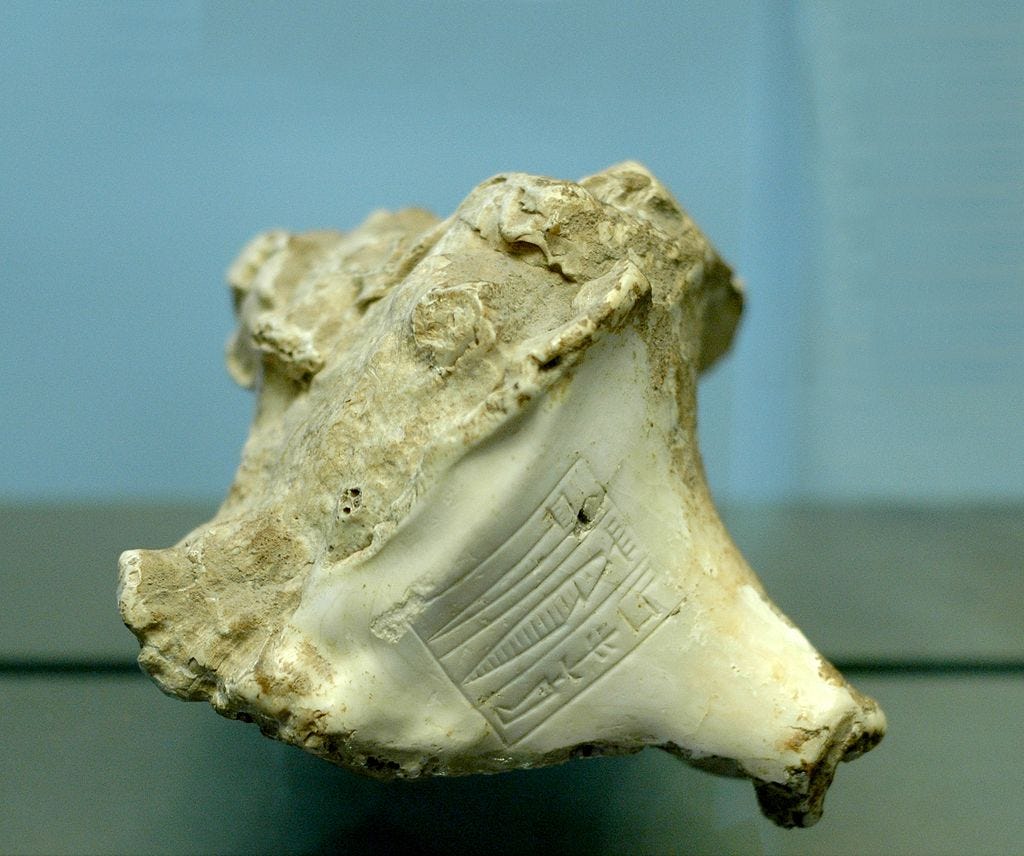The son of Sargon, Rimush, succeeds him on the throne. One of Rimush’s claims to fame was actually him fashioning a meteoric iron statue for the god Enlil, reportedly the first of its kind in the world.1 It would appear this era marked this advancement in the usage of iron despite there being over 1000 years left in the bronze age. This would mean iron was well known, but due to its scarce sourcing only from chance findings like meteoric iron and surface pockets, the actual smelting of weapons to arm a military was infeasible. Rimush was smart enough to understand its value, being the first to dedicate a religious object in this metal.
Depicted in the attached image is a murex sea shell - the very same origin for the supposed “Tyrian Dye” used by both Phonicians and Jews to make purple and blue dyes - bearing the name Rimush, king of Kish. Interesting here is his title as King of Kish, seemingly showing that might have actually been more important in certain far off lands having primacy still over the city of Akkad, which may have been more of an administrative city explaining its loss in later eras.
It appears Rimush was assassinated under uncertain circumstances based on a text from the Barutu compendium of extispicy divination records that states “If the heart is like a testicle - an omen of king Rimuš, whom his courtiers killed with their cylinder seals”.2 If we are to speculate why he was assassinated, perhaps it was the mass slaughter and genocide campaign he undertook that saw the widespread destruction and of nearly every major Sumerian city?3 (Not Shuruppak!)4 Between Adab and Zabala, Umma and Kian, Ur and Lagash, Kazallu, and three additional battles in Sumer we are given a total of 56,041 killed, 29,438 enslaved, and 25,685 ‘expelled’. 5
It is very obvious Rimush was an idiot, and didn’t foresee knocking out the entire known world's experts probably would have led to consequences culminating in his own assassination. In a turn of events, Rimush is assassinated by probably scribes who were using cylinder seals - either the chords by which these seals were strung, the needles with which the seals were attached, or even simply beaten to death. Given his treatment of the elites of the world, it’s no doubt others felt a prolonged reign of Rimush would have problems for the wider empire.
Douglas R. Frayne, "Akkad", The Sargonic and Gutian Periods (2334–2113), University of Toronto Press, pp. 5-218, 1993
Van De Mieroop, Marc, "The Structure of Knowledge of the Universe", Philosophy before the Greeks: The Pursuit of Truth in Ancient Babylonia, Princeton: Princeton University Press, pp. 113-140, 2015
Hamblin, William J. (2006). Warfare in the Ancient Near East to 1600 BC: Holy Warriors at the Dawn of History. Routledge. pp. 93–94.
Frahm, Eckart, and Elizabeth E. Payne, "Šuruppak under Rīmuš: A Rediscovered Inscription", Archiv Für Orientforschung, vol. 50, pp. 50–55, 2003
Fouts, David M., "Another Look at Large Numbers in Assyrian Royal Inscriptions", Journal of Near Eastern Studies, vol. 53, no. 3, pp. 205–11, 1994





